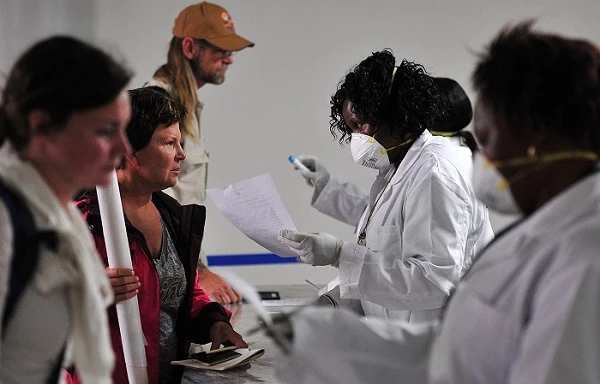
Tuesday Semptember 23, 2014
The number of Ebola cases in West Africa could reach 1.4 million by the end of January if trends continue without an immediate and massive scale-up in response, according to a new estimate by the Centers for Disease Control and Prevention.
The report released Tuesday is a tool the agency has developed to help with efforts to slow transmission of the epidemic and estimate the potential number of future cases. Researchers say the total number of cases is vastly underreported by a factor of 2.5 in Sierra Leone and Liberia, two of the three hardest-hit countries. Using this correction factor, researchers estimate that approximately 21,000 total cases will have occurred in Liberia and Sierra Leone by Sept. 30. Reported cases in those two countries are doubling approximately every 20 days, researchers said.
“Extrapolating trends to January 20, 2015, without additional interventions or changes in community behavior,” such as much-improved safe burial practices, the researchers estimate that the number of Ebola cases in Liberia and Sierra Leone could be between approximately 550,000 to 1.4 million.
“The findings in this report underscore the substantial public health challenges posed by the predicted number of future Ebola cases,” the researchers wrote. “If conditions continue without scale-up of interventions, cases will continue to double approximately every 20 days, and the number of cases in West Africa will rapidly reach extraordinary levels.”
They also said their assumptions may not fully account for sick patientswho are turned away from treatment centers that don’t have any spare beds. That suggests the number of underreported cases could be even higher.
CDC Director Tom Frieden cautioned that the estimates in the report don’t take into account actions taken or planned since August by the United States and the international community.
“We anticipate that these actions will slow the spread of the epidemic,” he said in a statement. The estimates in the report are based on data from August and “reflect a moment in time before recent significant increases in efforts to improve treatment and isolation.”
He said the tool developed by the CDC to make these projections provides the ability to help Ebola response planners make more informed decisions on the emergency response to help bring the outbreak under control – and what can happen if these resources are not brought to bear quickly.
“It is still possible to reverse the epidemic, and we believe this can be done if a sufficient number of all patients are effectively isolated, either in Ebola Treatment Units or in other settings, such as community-based or home care,” he said. “Once a sufficient number of Ebola patients are isolated, cases will decline very rapidly – almost as rapidly as they rose.”

The latest findings come as the World Health Organization’s official count for the outbreak has surged past 5,800 people infected and 2,800 deaths. New projections by the WHO published by the New England Journal of Medicine on Tuesday, also acknowledge that “the true numbers of cases and deaths are certainly higher.” The WHO says the number of cases couldquadruple to more than 20,000 by early November.
The CDC report offered a hypothetical scenario for slowing and eventually stopping the epidemic. In order for that to happen, about 70 percent of infected patients would need to be properly isolated and treated. Health officials and aid workers say only a tiny fraction of sick people are receiving the proper medical care.
The report also attached specific numbers showing the high cost of delay. Every month-long delay in increasing the percentage of patients in treatment to 70 percent results in a tripling of the number of daily cases.
The United States recently launched a $750 million effort to establish treatment facilities in Liberia, and the United Nations Security Council voted unanimously last week to create an emergency medical mission to respond to the outbreak. In addition, the WHO is launching an effort to move infected people out of their homes and into small centers that would provide at least rudimentary levels of care, in hopes of increasing survival rates and slowing the transmission of the disease.
Global health officials say the priority is Ebola treatment units, and those facilities are not arriving fast enough. It could be weeks, even months, before the 1,700 new treatment beds promised by Washington are operational.
CDC researchers said findings in the report do not take into account several factors that could affect the forecast. Substantial changes in movement of people within countries or across borders could affect the arc of the epidemic. Researchers are also assuming the current epidemic has incubation periods and other characteristics similar to previous outbreaks. The correction factor — needed to adjust for underreporting of cases — could “change substantially over time,” the report said. Regional differences in underreporting of cases “might mean that using one correction factor across an entire country is inappropriate.